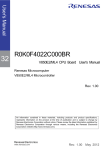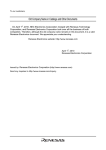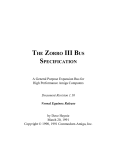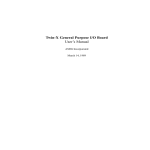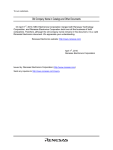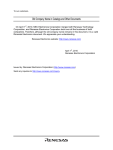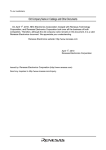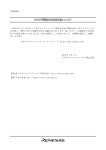Download IE-784928=NS-EM1 UM - Renesas Electronics
Transcript
To our customers, Old Company Name in Catalogs and Other Documents On April 1st, 2010, NEC Electronics Corporation merged with Renesas Technology Corporation, and Renesas Electronics Corporation took over all the business of both companies. Therefore, although the old company name remains in this document, it is a valid Renesas Electronics document. We appreciate your understanding. Renesas Electronics website: http://www.renesas.com April 1st, 2010 Renesas Electronics Corporation Issued by: Renesas Electronics Corporation (http://www.renesas.com) Send any inquiries to http://www.renesas.com/inquiry. Notice 1. 2. 3. 4. 5. 6. 7. All information included in this document is current as of the date this document is issued. Such information, however, is subject to change without any prior notice. Before purchasing or using any Renesas Electronics products listed herein, please confirm the latest product information with a Renesas Electronics sales office. Also, please pay regular and careful attention to additional and different information to be disclosed by Renesas Electronics such as that disclosed through our website. Renesas Electronics does not assume any liability for infringement of patents, copyrights, or other intellectual property rights of third parties by or arising from the use of Renesas Electronics products or technical information described in this document. No license, express, implied or otherwise, is granted hereby under any patents, copyrights or other intellectual property rights of Renesas Electronics or others. You should not alter, modify, copy, or otherwise misappropriate any Renesas Electronics product, whether in whole or in part. Descriptions of circuits, software and other related information in this document are provided only to illustrate the operation of semiconductor products and application examples. You are fully responsible for the incorporation of these circuits, software, and information in the design of your equipment. Renesas Electronics assumes no responsibility for any losses incurred by you or third parties arising from the use of these circuits, software, or information. When exporting the products or technology described in this document, you should comply with the applicable export control laws and regulations and follow the procedures required by such laws and regulations. You should not use Renesas Electronics products or the technology described in this document for any purpose relating to military applications or use by the military, including but not limited to the development of weapons of mass destruction. Renesas Electronics products and technology may not be used for or incorporated into any products or systems whose manufacture, use, or sale is prohibited under any applicable domestic or foreign laws or regulations. Renesas Electronics has used reasonable care in preparing the information included in this document, but Renesas Electronics does not warrant that such information is error free. Renesas Electronics assumes no liability whatsoever for any damages incurred by you resulting from errors in or omissions from the information included herein. Renesas Electronics products are classified according to the following three quality grades: “Standard”, “High Quality”, and “Specific”. The recommended applications for each Renesas Electronics product depends on the product’s quality grade, as indicated below. You must check the quality grade of each Renesas Electronics product before using it in a particular application. You may not use any Renesas Electronics product for any application categorized as “Specific” without the prior written consent of Renesas Electronics. Further, you may not use any Renesas Electronics product for any application for which it is not intended without the prior written consent of Renesas Electronics. Renesas Electronics shall not be in any way liable for any damages or losses incurred by you or third parties arising from the use of any Renesas Electronics product for an application categorized as “Specific” or for which the product is not intended where you have failed to obtain the prior written consent of Renesas Electronics. The quality grade of each Renesas Electronics product is “Standard” unless otherwise expressly specified in a Renesas Electronics data sheets or data books, etc. “Standard”: 8. 9. 10. 11. 12. Computers; office equipment; communications equipment; test and measurement equipment; audio and visual equipment; home electronic appliances; machine tools; personal electronic equipment; and industrial robots. “High Quality”: Transportation equipment (automobiles, trains, ships, etc.); traffic control systems; anti-disaster systems; anticrime systems; safety equipment; and medical equipment not specifically designed for life support. “Specific”: Aircraft; aerospace equipment; submersible repeaters; nuclear reactor control systems; medical equipment or systems for life support (e.g. artificial life support devices or systems), surgical implantations, or healthcare intervention (e.g. excision, etc.), and any other applications or purposes that pose a direct threat to human life. You should use the Renesas Electronics products described in this document within the range specified by Renesas Electronics, especially with respect to the maximum rating, operating supply voltage range, movement power voltage range, heat radiation characteristics, installation and other product characteristics. Renesas Electronics shall have no liability for malfunctions or damages arising out of the use of Renesas Electronics products beyond such specified ranges. Although Renesas Electronics endeavors to improve the quality and reliability of its products, semiconductor products have specific characteristics such as the occurrence of failure at a certain rate and malfunctions under certain use conditions. Further, Renesas Electronics products are not subject to radiation resistance design. Please be sure to implement safety measures to guard them against the possibility of physical injury, and injury or damage caused by fire in the event of the failure of a Renesas Electronics product, such as safety design for hardware and software including but not limited to redundancy, fire control and malfunction prevention, appropriate treatment for aging degradation or any other appropriate measures. Because the evaluation of microcomputer software alone is very difficult, please evaluate the safety of the final products or system manufactured by you. Please contact a Renesas Electronics sales office for details as to environmental matters such as the environmental compatibility of each Renesas Electronics product. Please use Renesas Electronics products in compliance with all applicable laws and regulations that regulate the inclusion or use of controlled substances, including without limitation, the EU RoHS Directive. Renesas Electronics assumes no liability for damages or losses occurring as a result of your noncompliance with applicable laws and regulations. This document may not be reproduced or duplicated, in any form, in whole or in part, without prior written consent of Renesas Electronics. Please contact a Renesas Electronics sales office if you have any questions regarding the information contained in this document or Renesas Electronics products, or if you have any other inquiries. (Note 1) “Renesas Electronics” as used in this document means Renesas Electronics Corporation and also includes its majorityowned subsidiaries. (Note 2) “Renesas Electronics product(s)” means any product developed or manufactured by or for Renesas Electronics. User’s Manual IE-784928-NS-EM1 Emulation Board IE-784928-NS-EM1 EP-784928GF-NS Target device µPD784915 Subseries µPD784928Y Subseries Document No. U13819EJ1V0UM00 (1st edition) Date Published April 1999 N CP(K) © 1999 Printed in Japan µPD784928 Subseries [MEMO] 2 User’s Manual U13819EJ1V0UM00 Windows is either a registered trademark or a trademark of Microsoft Corporation in the United States and/or other countries. PC/AT is a trademark of International Business Machines Corporation. The information in this document is subject to change without notice. No part of this document may be copied or reproduced in any form or by any means without the prior written consent of NEC Corporation. NEC Corporation assumes no responsibility for any errors which may appear in this document. NEC Corporation does not assume any liability for infringement of patents, copyrights or other intellectual property rights of third parties by or arising from use of a device described herein or any other liability arising from use of such device. No license, either express, implied or otherwise, is granted under any patents, copyrights or other intellectual property rights of NEC Corporation or of others. M7A 96. 10 User’s Manual U13819EJ1V0UM00 3 Regional Information Some information contained in this document may vary from country to country. Before using any NEC product in your application, pIease contact the NEC office in your country to obtain a list of authorized representatives and distributors. They will verify: • Device availability • Ordering information • Product release schedule • Availability of related technical literature • Development environment specifications (for example, specifications for third-party tools and components, host computers, power plugs, AC supply voltages, and so forth) • Network requirements In addition, trademarks, registered trademarks, export restrictions, and other legal issues may also vary from country to country. NEC Electronics Inc. (U.S.) NEC Electronics (Germany) GmbH NEC Electronics Hong Kong Ltd. Santa Clara, California Tel: 408-588-6000 800-366-9782 Fax: 408-588-6130 800-729-9288 Benelux Office Eindhoven, The Netherlands Tel: 040-2445845 Fax: 040-2444580 Hong Kong Tel: 2886-9318 Fax: 2886-9022/9044 NEC Electronics (France) S.A. Velizy-Villacoublay, France Tel: 01-30-67 58 00 Fax: 01-30-67 58 99 Seoul Branch Seoul, Korea Tel: 02-528-0303 Fax: 02-528-4411 NEC Electronics (France) S.A. NEC Electronics Singapore Pte. Ltd. Milton Keynes, UK Tel: 01908-691-133 Fax: 01908-670-290 Spain Office Madrid, Spain Tel: 91-504-2787 Fax: 91-504-2860 United Square, Singapore 1130 Tel: 65-253-8311 Fax: 65-250-3583 NEC Electronics Italiana s.r.l. NEC Electronics (Germany) GmbH Milano, Italy Tel: 02-66 75 41 Fax: 02-66 75 42 99 Scandinavia Office Taeby, Sweden Tel: 08-63 80 820 Fax: 08-63 80 388 NEC Electronics (Germany) GmbH Duesseldorf, Germany Tel: 0211-65 03 02 Fax: 0211-65 03 490 NEC Electronics (UK) Ltd. NEC Electronics Hong Kong Ltd. NEC Electronics Taiwan Ltd. Taipei, Taiwan Tel: 02-2719-2377 Fax: 02-2719-5951 NEC do Brasil S.A. Electron Devices Division Rodovia Presidente Dutra, Km 214 07210-902-Guarulhos-SP Brasil Tel: 55-11-6465-6810 Fax: 55-11-6465-6829 J99.1 4 User’s Manual U13819EJ1V0UM00 INTRODUCTION Product Overview The IE-784928-NS-EM1 is designed to be used with the IE-78K4-NS and dedicated emulation probe to debug the following target devices that belong to the 78K/IV Series of 16-bit single-chip microcontrollers. • µPD784915 Subseries: µPD784915, 784915A, 784915B, 784916A, 784916B, 78P4916 Target Readers • µPD784928 Subseries: µPD784927, 78F4928 • µPD784928Y Subseries: µPD784927Y, 78F4928Y This manual is intended for engineers who will use the IE-784928-NS-EM1 with the IE78K4-NS to perform system debugging. Engineers who use this manual are expected to be thoroughly familiar with the target device’s functions and use methods and to be knowledgeable about debugging. Organization When using the IE-784928-NS-EM1, refer to not only this manual (supplied with the IE784928-NS-EM1) but also the manual that is supplied with the IE-78K4-NS. IE-78K4-NS User’s Manual • Basic specifications IE-784928-NS-EM1 User’s Manual • General • System configuration • Part names • External interface functions • Installation • Differences between target devices and target interface circuits Purpose This manual’s purpose is to explain various debugging functions that can be performed when using the IE-784928-NS-EM1. User’s Manual U13819EJ1V0UM00 5 Terminology The meanings of certain terms used in this manual are listed below. Term Meaning Emulation device This is a general term that refers to the device in the emulator that is used to emulate the target device. It includes the emulation CPU. Emulation CPU This is the CPU block in the emulator that is used to execute user-generated programs. Target device This is the device (a real chip) that is the target for emulation. Target system The device that is targeted for debugging. This includes the target program and the hardware provided by the user. When defined narrowly, it includes only the hardware. IE system This refers to the combination of the IE-78K4-NS and the IE-784928-NS-EM1. Conventions Related Documents Data significance: Higher digits on the left and lower digits on the right Note: Footnote for item marked with Note in the text Caution: Information requiring particular attention Remark: Supplementary information The related documents (user’s manuals) indicated in this publication may include preliminary versions. However, preliminary versions are not marked as such. Document Name Document Number English IE-78K4-NS U13356E U13356J IE-784928-NS-EM1 This manual U13819J ID78K4-NS Integrated Debugger Reference Windows™ Based U12796E U12796J µPD784915 Subseries Hardware U10444E U10444J µPD784928 Subseries Hardware U12648E U12648J Caution The documents listed above are subject to change without notice. Be sure to use the latest documents when designing. 6 Japanese User’s Manual U13819EJ1V0UM00 CONTENTS CHAPTER 1 GENERAL ..............................................................................................................................11 1.1 System Configuration ............................................................................................................................... 12 1.2 Hardware Configuration............................................................................................................................ 14 1.3 Basic Specifications.................................................................................................................................. 15 CHAPTER 2 PART NAMES........................................................................................................................17 2.1 Parts of Emulation Board.......................................................................................................................... 18 2.2 Chipset Board Part Names ....................................................................................................................... 19 CHAPTER 3 INSTALLATION .....................................................................................................................21 3.1 Connection ................................................................................................................................................. 22 3.2 Target Device Setting ................................................................................................................................ 22 3.3 Clock Settings............................................................................................................................................ 23 3.3.1 Overview of clock settings ............................................................................................................. 23 3.3.2 Main system clock settings............................................................................................................ 25 3.3.3 Subsystem clock settings .............................................................................................................. 29 3.4 Pin Mask Function Settings...................................................................................................................... 30 3.5 Low-Voltage Emulation Setting................................................................................................................ 30 3.6 External Trigger ......................................................................................................................................... 31 CHAPTER 4 EMULATION PROBE (EP-784928GF-NS)............................................................................33 4.1 Configuration of EP-784928GF-NS........................................................................................................... 33 4.2 Connection Procedure .............................................................................................................................. 34 4.2.1 Emulation probe and target system connection (when using the 100-pin GF package) ............... 34 4.2.2 Emulation probe and target system connection (when using the 100-pin GC package) ............... 35 CHAPTER 5 DIFFERENCES BETWEEN TARGET DEVICES AND TARGET INTERFACE CIRCUITS ............37 User’s Manual U13819EJ1V0UM00 7 LIST OF FIGURES Figure No. Title Page Figure 1-1. System Configuration .................................................................................................................... 12 Figure 1-2. Basic Hardware Configuration ........................................................................................................ 14 Figure 2-1. IE-784928-NS-EM1 Part Names ..................................................................................................... 18 Figure 2-2. Chipset Board Part Names.............................................................................................................. 19 Figure 3-1. Mounting of Chipset Board .............................................................................................................. 22 Figure 3-2. External Circuits Used as System Clock Oscillator ........................................................................... 23 Figure 3-3. When Using Clock That Is Already Mounted on Emulation Board ...................................................... 24 Figure 3-4. When Using User-Mounted Clock ................................................................................................... 24 Figure 3-5. When Using an External Clock ....................................................................................................... 25 Figure 3-6. Connections on Parts Board (When Using Main System Clock or User-Mounted Clock) ...................... 26 Figure 3-7. Crystal Oscillator (When Using Main System Clock or User-Mounted Clock) ...................................... 28 Figure 3-8. Pin Alignment of Crystal Oscillator and Socket................................................................................. 28 Figure 3-9. External Trigger Input Position ....................................................................................................... 31 Figure 4-1. EP-784928GF-NS Configuration Diagram ........................................................................................ 33 Figure 4-2. Emulation Probe and Target System Connection (When Using the 100-Pin GF Package) .................... 34 Figure 4-3. EP-784928GF-NS and Target System Connection (When Using the 100-Pin GC Package) .................. 35 Figure 5-1. Equivalent Circuit 1 of Emulation Circuit ........................................................................................... 38 Figure 5-2. Equivalent Circuit 2 of Emulation Circuit .......................................................................................... 39 Figure 5-3. Equivalent Circuit 3 of Emulation Circuit .......................................................................................... 40 8 User’s Manual U13819EJ1V0UM00 LIST OF TABLES Table No. Title Page Table 1-1. Basic Specifications ........................................................................................................................15 Table 3-1. Main System Clock Settings.............................................................................................................25 Table 3-2. Slide Switch Setting for NMI Interrupt Mask Function ..........................................................................30 User’s Manual U13819EJ1V0UM00 9 [MEMO] 10 User’s Manual U13819EJ1V0UM00 CHAPTER 1 GENERAL The IE-784928-NS-EM1 is a development tool for efficient debugging of hardware or software when using one of the following target devices that belong to the 78K/IV Series of 16-bit single-chip microcontrollers. This chapter describes the IE-784928-NS-EM1’s system configuration and basic specifications. • Target device • µPD784915 Subseries • µPD784928 Subseries • µPD784928Y Subseries User’s Manual U13819EJ1V0UM00 11 CHAPTER 1 GENERAL 1.1 System Configuration Figure 1-1 illustrates the IE-784928-NS-EM1’s system configuration. Figure 1-1. System Configuration Device file Note (sold separately) Debugger ID78K4-NS (sold separately) Control software Host machine PC-9800 series or IBM PC/ATTM or compatibles Interface board IE-70000-98-IF-C (sold separately) Interface board IE-70000-PC-IF-C (sold separately) Interface board IE-70000-PCI-IF (sold separately) Interface card or Interface cable Interface cable (NS IF Cable) IE-78K4-NS (sold separately) In-circuit emulator G-784928 IO Board 4915NS CHIPSET MC CARD Cable IE-70000-CD-IF-A (sold separately) FG Cable AC adapter IE-70000-MC-PS-B (sold separately) NS CARD Cable IE-784928-NS-EM1 (This product) 4928 CHIPSET Conversion socket NEV-921GF-100 12 TGC-100SDW 4915 YQ PACK PKG 4928 GC DUMMY User’s Manual U13819EJ1V0UM00 Dedicated emulation probe EP-784928GF-NS (sold separately) CHAPTER 1 GENERAL Note The device file is as follows, in accordance with the subseries. µS××××DF784915: µPD784915 Subseries µS××××DF784928: µPD784928, 784928Y Subseries User’s Manual U13819EJ1V0UM00 13 CHAPTER 1 GENERAL 1.2 Hardware Configuration Figure 1-2 shows the IE-784928-NS-EM1’s position in the basic hardware configuration. Figure 1-2. Basic Hardware Configuration Dedicated bus interface IE system IE-78K4-NS Host machine Interface board (sold separately) Interface card (sold separately) 78K4 main board 78K4 emulation board IE-784928-NS-EM1 I/O emulation board 4928 chipset board Dedicated emulation probe EP-784928GF-NS (sold separately) 14 User’s Manual U13819EJ1V0UM00 4915NS chipset board CHAPTER 1 GENERAL 1.3 Basic Specifications The IE-784928-NS-EM1’s basic specifications are listed in Table 1-1. Table 1-1. Basic Specifications Parameter Description Target device µPD784915, 784928, 784928Y Subseries System clock Main system clock: 8 MHz Subsystem clock: 32.768 kHz Main clock supply External: Input via an emulation probe from the target system Internal: Mounted on emulation board (16 MHz), or mounted on the board by the user Subsystem clock supply Internal: Mounted on emulation board (32.768 kHz) Low-voltage support 2.7 V or higher (same as target device) User’s Manual U13819EJ1V0UM00 15 [MEMO] 16 User’s Manual U13819EJ1V0UM00 CHAPTER 2 PART NAMES This chapter introduces the parts of the IE-784928-NS-EM1 main unit and the chipset boards. The packing box contains the emulation board (IE-784928-NS-EM1), and two chipset boards (4915NS CHIPSET, 4928 CHIPSET). If there are any missing or damaged items, please contact an NEC sales representative. Fill out and return the guarantee document that comes with the main unit. User’s Manual U13819EJ1V0UM00 17 CHAPTER 2 PART NAMES 2.1 Parts of Emulation Board TP1 Figure 2-1. IE-784928-NS-EM1 Part Names X1 socket GND TP1 Low Volt EXTOUT (TP3) EXTIN (TP4) Crystal resonator for subsystem clock L1 CN1 Connector for probe tip board connection (L1, L2) L2 Probe connector CN1 EP-784928GF-NS TVCC LED1 IE-784928-NS-EM1 18 User’s Manual U13819EJ1V0UM00 CHAPTER 2 PART NAMES 2.2 Chipset Board Part Names Figure 2-2. Chipset Board Part Names ON OFF ON SW1 OFF SW1 L2 L1 4915NS CHIPSET L2 L1 4928 CHIPSET The IE-784928-NS-EM1 includes the 4915NS CHIPSET and the 4928 CHIPSET. (1) When the 4915NS CHIPSET is used to emulate the µPD784915 Subseries, use the 4928 CHIPSET to emulate the µPD784928 and 784928Y Subseries. (2) When using an emulation probe, connect the 4915NS CHIPSET or the 4928 CHIPSET to the probe tip. (3) When not using an emulation probe, connect the 4915NS CHIPSET or the 4928 CHIPSET to the L1 and L2 connectors on the IE-784928-NS-EM1. Caution Do not connect the chipset boards to both the emulation probe tip and the L1 and L2 connectors on the IE-784928-NS-EM1 at the same time. User’s Manual U13819EJ1V0UM00 19 [MEMO] 20 User’s Manual U13819EJ1V0UM00 CHAPTER 3 INSTALLATION This chapter describes methods for connecting the IE-784928-NS-EM1 to the IE-78K4-NS, emulation probe, or chipset boards. Mode setting methods are also described. Caution Connecting or removing components to or from the target system, or making switch or other setting changes must be carried out after the power supply to both the IE system and the target system has been switched OFF. User’s Manual U13819EJ1V0UM00 21 CHAPTER 3 INSTALLATION 3.1 Connection (1) Connection to chipset board Connect the 4915NS CHIPSET or the 4928 CHIPSET to the L1 and L2 connectors on the IE-784928-NS-EM1. Figure 3-1. Mounting of Chipset Board Chipset board L1 L2 Caution Do not connect the chipset board while the emulation probe is in use. (2) Connection with IE-78K4-NS main unit See the IE-78K4-NS User’s Manual (U13356E) for a description of how to connect the IE-784928-NS-EM1 to the IE-78K4-NS. (3) Connection with emulation probe See CHAPTER 4 EMULATION PROBE (EP-784928GF-NS) for a description of how to connect an emulation probe to the IE-784928-NS-EM1. On this board, connect the emulation probe to CN1. Caution A clock cannot be supplied to the emulation device from the oscillation clock in the target system. When operating at a frequency other than 16 MHz, attach a clock device of the same oscillation frequency as that supplied to the target device to X1. 3.2 Target Device Setting When emulating the µPD784915 Subseries, connect the 4915NS CHIPSET to L1 and L2. When emulating the µPD784928 and µPD784928Y Subseries, connect the 4928 CHIPSET to L1 and L2. 22 User’s Manual U13819EJ1V0UM00 CHAPTER 3 INSTALLATION 3.3 Clock Settings 3.3.1 Overview of clock settings The main system clock to be used during debugging can be selected from (1) to (3) below. (1) Clock that is already mounted on emulation board (2) Clock that is mounted by user (3) External clock Caution Use “clock that is already mounted on emulation board” for the subsystem clock. If the target system includes an internal clock, select either “(1) Clock that is already mounted on emulation board” or “(2) Clock that is mounted by user”. For an internal clock, the target device is connected to a resonator and the target device’s internal oscillator is used. An example of the external circuit is shown in part (a) of Figure 3-2. During emulation, the resonator that is mounted on the target system is not used. Instead, the clock that is mounted on the emulation board, which is installed for the IE-78K4-NS is used. If the target system includes an external clock, select “(3) External clock”. For an external clock, a clock signal is supplied from outside of the target device and the target device’s internal oscillator is not used. An example of the external circuit is shown in part (b) of Figure 3-2. Figure 3-2. External Circuits Used as System Clock Oscillator (a) Internal clock (b) External clock Target device X1 Target device External clock X2 X1 X2 User’s Manual U13819EJ1V0UM00 23 CHAPTER 3 INSTALLATION (1) Clock that is already mounted on emulation board A crystal oscillator is already mounted on the emulation board. Its frequency is 16 MHz. Figure 3-3. When Using Clock That Is Already Mounted on Emulation Board IE-78K4-NS Target system IE-784928-NS-EM1 Mounted oscillator (to be used) Emulation probe Resonator (not used) Remark The clock that is supplied by the IE-784928-NS-EM1’s oscillator (encircled in the figure) is used. (2) Clock that is mounted by user The user is able to mount any clock supported by the set specifications on the IE-784928-NS-EM1. First mount the resonator on the parts board, then attach the parts board to the IE-784928-NS-EM1. This method is useful when using a different frequency from that of the pre-mounted clock. Figure 3-4. When Using User-Mounted Clock IE-78K4-NS Target system IE-784928-NS-EM1 Parts board Emulation probe Resonator (to be used) Resonator (not used) Remark The clock that is supplied by the IE-784928-NS-EM1’s resonator (encircled in the figure) is used. 24 User’s Manual U13819EJ1V0UM00 CHAPTER 3 INSTALLATION (3) External clock An external clock connected to the target system can be used via an emulation probe. Figure 3-5. When Using an External Clock IE-78K4-NS Target system IE-784928-NS-EM1 Emulation probe Clock generator (to be used) Remark The clock supplied by the target system’s clock generator (encircled in the figure) is used. 3.3.2 Main system clock settings Table 3-1. Main System Clock Settings Frequency of Main System Clock IE-784928-NS-EM1 Parts Board (X1) When using clock that is already mounted on emulation board 16 MHz Oscillator used When using clock mounted by user Other than 16 MHz Oscillator assembled by user When using external clock Caution Oscillator not used CPU Clock Source Selection (ID) Internal External When using an external clock, open the configuration dialog box when starting the integrated debugger (ID78K4-NS) and select “External” in the area (Clock) for selecting the CPU’s clock source (this selects the user’s clock). Remark The IE-784928-NS-EM1’s factory settings are those listed above under “when using clock that is already mounted on emulation board”. (1) When using clock that is already mounted on emulation board When the IE-784928-NS-EM1 is shipped, a 16-MHz crystal oscillator is already mounted in the IE-784928-NSEM1’s X1 socket. When using the factory-set mode settings, there is no need to make any other hardware settings. When starting the integrated debugger (ID78K4-NS), open the configuration dialog box and select “Internal” in the area (Clock) for selecting the CPU’s clock source (this selects the emulator’s internal clock). User’s Manual U13819EJ1V0UM00 25 CHAPTER 3 INSTALLATION (2) When using clock mounted by user The settings described under either (a) or (b) are required, depending on the type of clock to be used. When starting the integrated debugger (ID78K4-NS), open the configuration dialog box and select “Internal” in the area (Clock) for selecting the CPU’s clock source (this selects the emulator’s internal clock). (a) When using a ceramic resonator or crystal resonator • Items to be prepared • Parts board (supplied with IE-78K4-NS) • Capacitor CA • Ceramic resonator or crystal resonator • Capacitor CB • Resistor Rx • Solder kit <Steps> <1> Solder the target ceramic resonator or crystal resonator, resistor Rx, capacitor CA, and capacitor CB (all with suitable oscillation frequency) onto the supplied parts board (as shown below). Figure 3-6. Connections on Parts Board (When Using Main System Clock or User-Mounted Clock) Parts board (X1) 1 14 Pin No. 2 13 2-13 Capacitor CB 3 12 3-12 Capacitor CA 4 11 5 10 4-11 Ceramic resonator or crystal resonator 6 9 5-10 Resistor Rx 7 8 8-9 Short Connection Circuit diagram 1 MΩ HCU04 HCU04 5 Rx 10 4 3 CA 12 98 CLOCK OUT 11 13 CB 2 Remark The sections enclosed in broken lines indicate parts that are attached to the parts board. 26 User’s Manual U13819EJ1V0UM00 CHAPTER 3 INSTALLATION <2> Prepare the IE-784928-NS-EM1. <3> Remove the crystal oscillator that is mounted in the IE-784928-NS-EM1’s socket (the socket marked as X1). <4> Connect the parts board (from <1> above) to the socket (X1) from which the crystal oscillator was removed. Check the pin 1 mark to make sure the board is mounted in the correct direction. <5> Make sure that the parts board mounted in the X1 socket on the emulation board is wired as shown in Figure 3-6 above. <6> Install the IE-784928-NS-EM1 in the IE-78K4-NS. The above steps configure the following circuit and enable supply of the clock from the mounted resonator to the emulation device. IE-78K4-NS side (Emulation device) VCC 1 MΩ 4.7 kΩ VHC244 6 HCU04 HCU04 9 CLK IN 8 5 VCC A Rx 10 X 4 3 CA 12 11 Y B AC125 VHC157 X1 13 CB 2 HSK120 Remark The sections enclosed in broken lines indicate parts that are attached to the parts board. User’s Manual U13819EJ1V0UM00 27 CHAPTER 3 INSTALLATION (b) When using a crystal oscillator • Items to be prepared • Crystal oscillator (see pinouts shown in Figure 3-7) Figure 3-7. Crystal Oscillator (When Using Main System Clock or User-Mounted Clock) VCC NC GND CLOCK OUT <Steps> <1> Prepare the IE-784928-NS-EM1. <2> Remove the crystal oscillator that is mounted in the IE-784928-NS-EM1’s socket (the socket marked as X1). <3> Connect the crystal oscillator (from <2> above) to the socket (X1) from which the crystal oscillator was removed. Insert the crystal oscillator pin into the socket aligning the pins as shown in the figure below. Figure 3-8. Pin Alignment of Crystal Oscillator and Socket Crystal oscillator NC GND Socket VCC CLOCK OUT 1 14 2 13 3 12 4 11 5 10 6 9 7 8 Crystal Oscillator Pin Name Socket Pin No. NC 1 GND 7 CLOCK OUT 8 VCC 14 <4> Install the IE-784928-NS-EM1 in the IE-78K4-NS. 28 User’s Manual U13819EJ1V0UM00 CHAPTER 3 INSTALLATION The above steps configure the following circuit and enable supply of the clock from the mounted resonator to the emulation device. VCC IE-78K4-NS side (Emulation device) VCC Crystal oscillator 4.7 kΩ VHC244 VCC A Y CLK IN B AC125 VHC157 X1 HSK120 (3) When using external clock No hardware settings are required for this situation. When starting the integrated debugger (ID78K4-NS), open the configuration dialog box and select “External” in the area (Clock) for selecting the CPU’s clock source (this selects the user’s clock). 3.3.3 Subsystem clock settings When the IE-784928-NS-EM1 is shipped, a 32.768-kHz crystal resonator is already mounted in the IE-784928NS-EM1. The system clock cannot be changed. User’s Manual U13819EJ1V0UM00 29 CHAPTER 3 INSTALLATION 3.4 Pin Mask Function Settings • NMI interrupt mask setting By setting a switch (SW1) on the 4915NS CHIPSET, or 4928 CHIPSET in the IE-784928-NS-EM1, it is possible to mask the NMI interrupt, which is the alternate function of the P20 pin. Table 3-2. Slide Switch Setting for NMI Interrupt Mask Function Status Slide Switch Setting SW1 No NMI mask (initial setting) OFF NMI masked ON Caution Because the NMI interrupt is the alternate function of the P02/INTP2 pin, this pin cannot operate as the P02/INTP2 pin when the NMI mask status has been set. 3.5 Low-Voltage Emulation Setting Low-voltage emulation is possible in the IE system. When the target system is operating on low voltage, supply the same voltage as the target system to the TP1 terminal pin of the IE-784928-NS-EM1 (this is unnecessary when TP1 is 5 V). Set the target voltage between 2.7 and 5 V. • Maximum current consumption of TP1 30 5V 300 mA . . . . . . 2.7 V 150 mA User’s Manual U13819EJ1V0UM00 CHAPTER 3 INSTALLATION 3.6 External Trigger To set up an external trigger, connect it to the IE-784928-NS-EM1’s check pin, EXTOUT pin, and EXTIN pin as shown below. See the integrated debugger (ID-78K4-NS) User’s Manual (U12796E) for descriptions of related use methods and pin characteristics. Figure 3-9. External Trigger Input Position X1 socket TP1 EXTOUT EXTIN User’s Manual U13819EJ1V0UM00 31 [MEMO] 32 User’s Manual U13819EJ1V0UM00 CHAPTER 4 EMULATION PROBE (EP-784928GF-NS) When using the IE-784928-NS-EM1 connected to the target system, a dedicated emulation probe (EP-784928GFNS: sold separately) is needed. Using the EP-784928GF-NS for connection enables debugging of the hardware and software of the target system in which the µPD784915, µPD784928, or µPD784928Y Subseries are employed. For connection details, refer to 4.2 Connection Procedure. 4.1 Configuration of EP-784928GF-NS The configuration of the EP-784928GF-NS is described below. • EP-784928GF-NS • Probe tip board (DUMMY BOARD): 4915 YQ PACK PKG (100GF) • Probe tip board (DUMMY BOARD): 4928 GC DUMMY (100GC) • Conversion socket: NEV921GF-100 • Conversion socket: TGC-100SDW Caution Chipset boards are not included with the EP-784928GF-NS, so use the 4915 NS CHIPSET and 4928 CHIPSET included with the IE-784928-NS-EM1. Figure 4-1. EP-784928GF-NS Configuration Diagram EP-784928GF-NS 4915 YQ PACK PKG (100GF) 4928 GC DUMMY (100GC) TGC-100SDW NEV921GF-100 User’s Manual U13819EJ1V0UM00 33 CHAPTER 4 EMULATION PROBE (EP-784928GF-NS) 4.2 Connection Procedure 4.2.1 Emulation probe and target system connection (when using the 100-pin GF package) (1) Solder the accompanying conversion socket (NEV921GF-100) to the target system. (2) Connect the 4915 YQ PACK PKG (DUMMY BOARD) to the soldered conversion socket (NEV921GF-100), and fix with screws. (3) Plug the emulation probe tip into the 4915 YQ PACK PKG (DUMMY BOARD). Figure 4-2. Emulation Probe and Target System Connection (When Using the 100-Pin GF Package) EP-784928GF-NS 4915NS CHIPSET or 4928 CHIPSET CN 1 IE-78K4-NS 4915 YQ PACK PKG Target system NEV921GF-100 34 User’s Manual U13819EJ1V0UM00 CHAPTER 4 EMULATION PROBE (EP-784928GF-NS) 4.2.2 Emulation probe and target system connection (when using the 100-pin GC package) (1) Solder the accompanying conversion socket (TGC-100SDW) to the target system. (2) Connect the 4928 GC DUMMY (DUMMY BOARD) to the soldered conversion socket (TGC-100SDW), and fix with screws. (3) Plug the emulation probe tip into the 4928 GC DUMMY (DUMMY BOARD). Figure 4-3. EP-784928GF-NS and Target System Connection (When Using the 100-Pin GC Package) EP-784928GF-NS 4915NS CHIPSET or 4928 CHIPSET CN 1 IE-78K4-NS 4928 GC DUMMY Target system TGC-100SDW User’s Manual U13819EJ1V0UM00 35 [MEMO] 36 User’s Manual U13819EJ1V0UM00 CHAPTER 5 DIFFERENCES BETWEEN TARGET DEVICES AND TARGET INTERFACE CIRCUITS This chapter describes differences between the target device’s signal lines and the signal lines of the IE-784928NS-EM1’s target interface circuit. Although the target device is a CMOS circuit, the IE-784928-NS-EM1’s target interface circuit consists of an emulation CPU, TTL, CMOS-IC, and other emulation circuits. When the IE system is connected with the target system for debugging, the IE system performs emulation so as to operate as the actual target device would operate in the target system. However, some minor differences exist since the operations are performed via the IE system’s emulation. (1) Signals directly input/output to/from the emulation CPU (2) Signals input from the target system via a gate (3) Other signals The IE system’s circuit is used as follows for signals listed in (1) to (3) above. (1) Signals directly input/output to/from the emulation CPU The following signals perform the same operations as in the µPD784915, 784928 Subseries. For the signals related to ports 0, 4, and 5, a 22-Ω resistor is inserted in series. The NMI performs mask control by means of SW1 on the chipset board. • Signals related to port 0 • Signals related to port 4 • Signals related to port 5 • Signals related to port 6 • Signals related to port 7 (A/D converter input) • Signals related to port 8 • Signals related to port 9 • Signals related to external input (INTP0 to INTP2) • Signals related to timer output (PT00 to PT02) • Signals related to serial communication (SCK2, SO2, SI2/BUSY) • Signals related to A/D converter (ANI08 to ANI11) • NMI User’s Manual U13819EJ1V0UM00 37 CHAPTER 5 DIFFERENCES BETWEEN TARGET DEVICES AND TARGET INTERFACE CIRCUITS Figure 5-1. Equivalent Circuit 1 of Emulation Circuit Probe side IE system side 22 Ω P00 to P07 P00 to P07 1 MΩ 22 Ω P40 to P47 P40 to P47 1 MΩ 22 Ω P50 to P57 P50 to P57 1 MΩ P60 to P67 P60 to P67 P70 to P77 P70 to P77 P80 to P87 P80 to P87 P90 to P96 P90 to P96 REEL0IN REEL0IN REEL1IN REEL1IN CSYNCIN CSYNCIN DFGIN DFGIN DPGIN DPGIN CFGIN CFGIN CFGAMPO CFGAMPO CFGCPIN CFGCPIN CTLDLY CTLDLY RECCTL+ RECCTL+ RECCTL RECCTL CTLIN 38 CTLIN CTLOUT1 CTLOUT1 CTLOUT2 CTLOUT2 User’s Manual U13819EJ1V0UM00 CHAPTER 5 DIFFERENCES BETWEEN TARGET DEVICES AND TARGET INTERFACE CIRCUITS Figure 5-2. Equivalent Circuit 2 of Emulation Circuit Probe side IE system side VREFC VREFC INTP0 to INTP2 INTP0 to INTP2 PTO00 to PTO02 PTO00 to PTO02 SCK2 SCK2 SO2 SO2 SI2/BUSY SI2/BUSY ANI08 to ANI11 ANI08 to ANI11 LVCC 4.7 kΩ NMI NMI AVDD1 AVDD1 LVCC AVDD2 Leave open AVDD2 AVSS1 AVSS1 AVSS2 AVSS2 User’s Manual U13819EJ1V0UM00 39 CHAPTER 5 DIFFERENCES BETWEEN TARGET DEVICES AND TARGET INTERFACE CIRCUITS (2) Signals input from the target system via a gate Since the following signals are input via a gate, their timing shows a delay compared to that of the µPD784915, 784928 Subseries. Their AC characteristics and DC characteristics are therefore different from the µPD784928 Subseries, making it necessary to observe a stricter timing design than in the case of the µPD784915, 784928 Subseries. • PWM0, PWM1 • RESET signal Figure 5-3. Equivalent Circuit 3 of Emulation Circuit Probe side IE system side VHC244 PWM0, 1 PWM0, 1 LVCC 4.7 kΩ VHC244 ACT244 STOP RESET 27 Ω (3) Other signals • VDD pin When the emulation CPU is operating at 5 V, its power is supplied from the internal IE system, but when operating at low voltage, its power is supplied from the low-voltage pin (TP1). The VDD pin of the target system is only used to control the LED (USERVDD) in the IE system that monitors the input of the target system's power supply. • VSS pin The VSS pin is connected to GND inside the IE system. 40 User’s Manual U13819EJ1V0UM00 [MEMO] User’s Manual U13819EJ1V0UM00 41 [MEMO] 42 User’s Manual U13819EJ1V0UM00 Facsimile Message From: Name Company Tel. Although NEC has taken all possible steps to ensure that the documentation supplied to our customers is complete, bug free and up-to-date, we readily accept that errors may occur. Despite all the care and precautions we've taken, you may encounter problems in the documentation. Please complete this form whenever you'd like to report errors or suggest improvements to us. FAX Address Thank you for your kind support. North America Hong Kong, Philippines, Oceania NEC Electronics Inc. NEC Electronics Hong Kong Ltd. Corporate Communications Dept. Fax: +852-2886-9022/9044 Fax: 1-800-729-9288 1-408-588-6130 Korea Europe NEC Electronics Hong Kong Ltd. NEC Electronics (Europe) GmbH Seoul Branch Technical Documentation Dept. Fax: 02-528-4411 Fax: +49-211-6503-274 South America NEC do Brasil S.A. Fax: +55-11-6465-6829 Asian Nations except Philippines NEC Electronics Singapore Pte. Ltd. Fax: +65-250-3583 Japan NEC Semiconductor Technical Hotline Fax: 044-548-7900 Taiwan NEC Electronics Taiwan Ltd. Fax: 02-2719-5951 I would like to report the following error/make the following suggestion: Document title: Document number: Page number: If possible, please fax the referenced page or drawing. Document Rating Excellent Good Acceptable Poor Clarity Technical Accuracy Organization CS 99.1













































